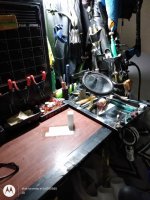jimmie
Jr. Shave Member
okay. overlooking my lack of professional terminology. on a synthetic Stone, you make us slurry by using a diamond plate? they have different grits of diamond plates. my question is.
if the diamond plate just turns the stone into a slurry , does it matter what grit diamond plate you use to make this slurry? I don't understand, if the grit from the diamond plate is adding to the slurry or what exactly is going on. do I need different diamond plates and how much difference does a slurry actually make. I understand it's useful to watch the water ride up on the blade and whatnot, but is it actually doing anything. if I sharpen two razors one with a slurry one with not, you can tell me which one was with, and which one was without?
I'm just trying to figure out where to draw the lines. you want to collect razors, and then of course you have to collect brushes and then you have to collect soaps and strops. and then natural stones have a collectibility LOL. it never stops so I have to draw the line somewhere I have two Norton's and one shapton 1200
if the diamond plate just turns the stone into a slurry , does it matter what grit diamond plate you use to make this slurry? I don't understand, if the grit from the diamond plate is adding to the slurry or what exactly is going on. do I need different diamond plates and how much difference does a slurry actually make. I understand it's useful to watch the water ride up on the blade and whatnot, but is it actually doing anything. if I sharpen two razors one with a slurry one with not, you can tell me which one was with, and which one was without?
I'm just trying to figure out where to draw the lines. you want to collect razors, and then of course you have to collect brushes and then you have to collect soaps and strops. and then natural stones have a collectibility LOL. it never stops so I have to draw the line somewhere I have two Norton's and one shapton 1200

